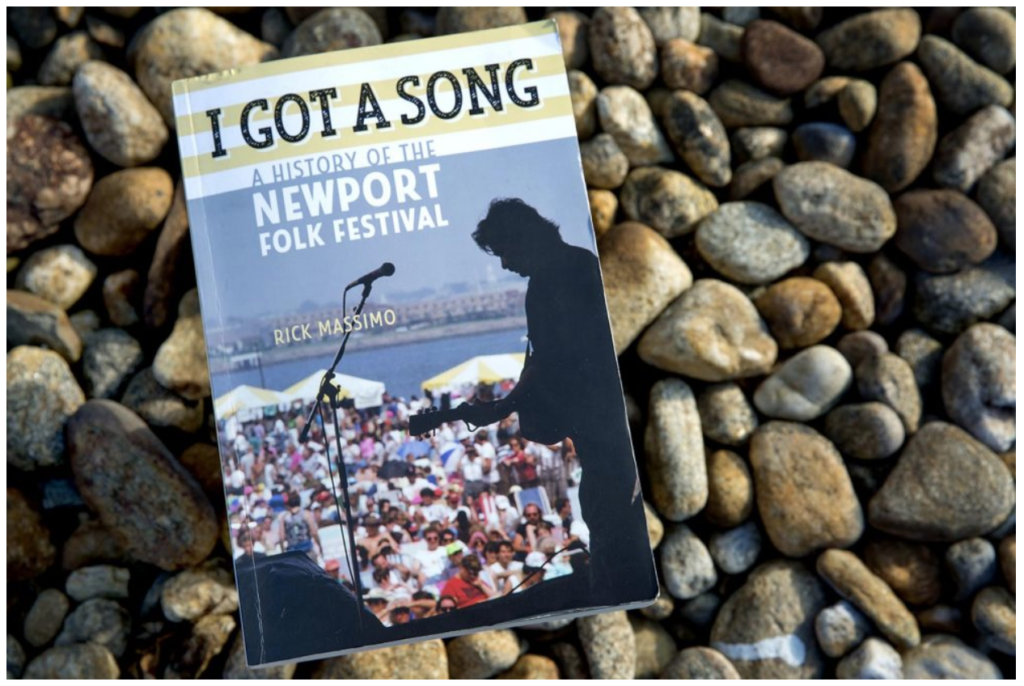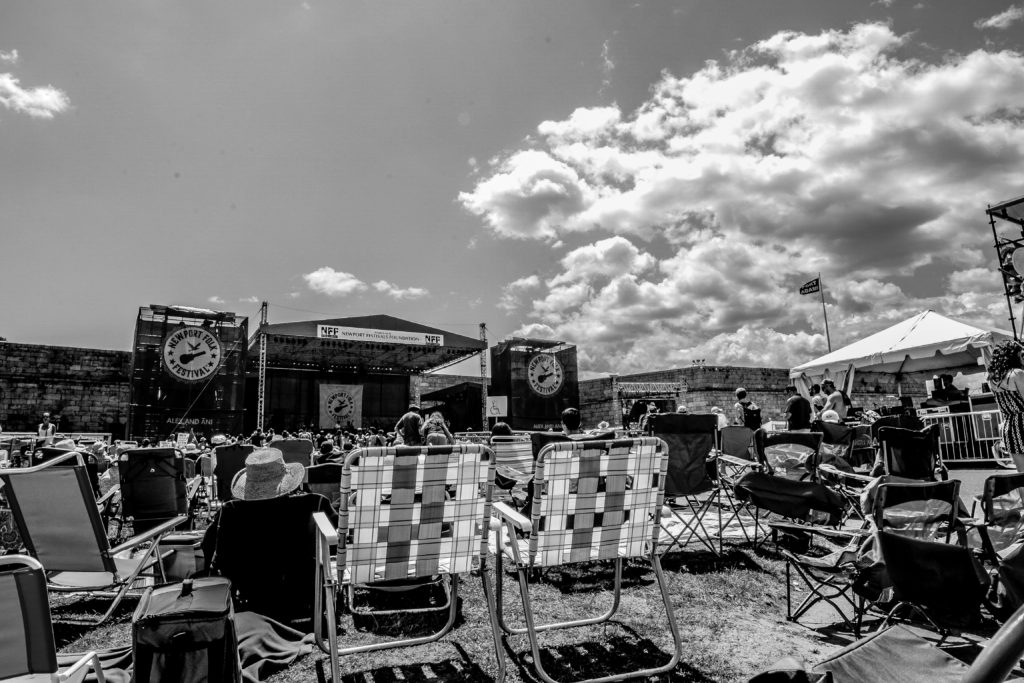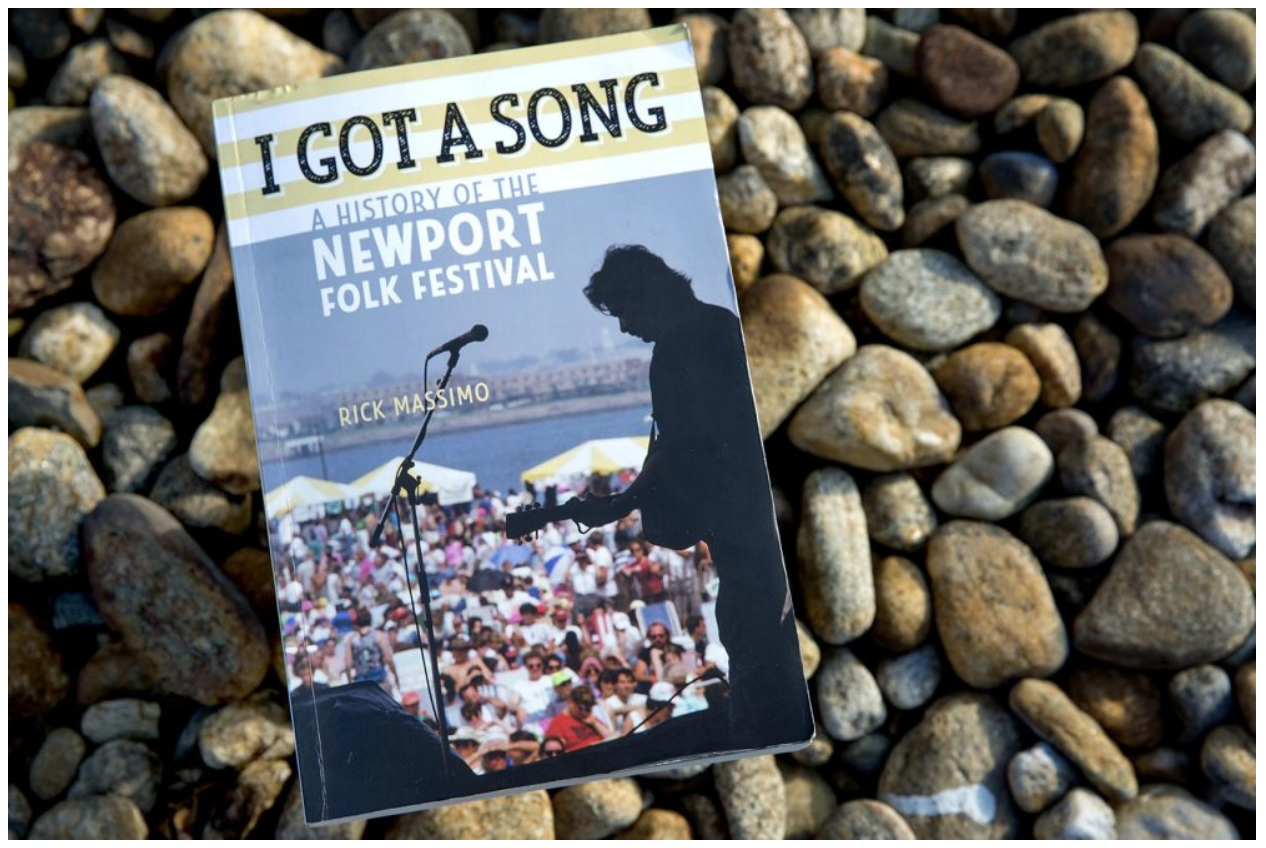An Interview with Rick Massimo, I Got A Song
At last year’s Newport Folk Festival, Rick Massimo unveiled his long-awaited history of the festival, I Got A Song. It’s an engrossing, thoughtful take on the Festival’s origins and its shifting position in American music. As with much history, there is much you probably “know” about Newport that is just slightly false or is at least contested. This spectre of dubious memory comes to the fore in Massimo’s chapter on the 1965 festival, when Dylan went electric: he brilliantly presents the entire chapter with quotations from people who were there, offering no editorial commentary (even when individuals contradict their own earlier statements). There is much in the book that will surprise readers: the fact that for much of its history, the festival had a tense relationship with the city of Newport; that the festival has gone through dire financial straits in the past; and, a fact that has escaped many performers, that the festival hasn’t always been at Fort Adams. But while the facts of the festival’s evolution are interesting, especially the early recruitment efforts for authentic acts, it is Massimo’s reflection on the shifting landscape of folk music that got my gears turning. So, if you are gearing up for Newport 2018, this book is a great read to have a deeper understanding of the history of the festival. Reading it certainly made me appreciate my experiences at Newport in a far deeper way and it was great to chat with Rick about the evolution of this project, the tensions of folk music in general, and the memories that make Newport special to him.

RLR: For those who might not have read it yet, how did your idea for this book come about?
RM: I wrote for the Providence Journal for nine years, covering all aspects of music, and in that time I covered nine Newport Folk Festivals, including 2009, the 50th anniversary festival. I proposed a series of stories and they sent me down to New York to spend a day with George Wein. I hung out with him in his apartment for about an hour or two, and then we went to this [Newport] Jazz Festival event in Manhattan, and then we went back to his apartment for about three more hours. That was the catalyst. I was on the train ride back to Providence and I started making a little outline for what the series of stories was going to be, and that’s when I had the first inkling that someone could write a book about this. My first thought was that somebody must have [written this kind of book already, but] at a certain point, I crossed a critical mass of interviews where I thought, “If someone’s writing this book, then they haven’t talked to George Wein, or Bob Jones, they haven’t talked to Pete Seeger, they haven’t talked to Jay Sweet, so if there’s a thing out there, it’s not much of a thing,” and that’s when I felt OK moving ahead.
There were a lot of pretty lucky breaks that fell my way to be able to do it. It’s been eight years in the making, so I’m very happy to have it complete. I didn’t know I was going to sign with a university press and I think it became a better book for it. Wesleyan University Press was very much about: what does it all mean? Coming at it as a journalist, I was telling a factual story, and they were the ones who said, read this book and that book, and apply their theories about folk music and conceptual frameworks and show where Newport applies and doesn’t apply.
RLR: Was there something that really struck you that you felt compelled to get into the common knowledge about this festival?
RM: It’s hard to say what’s common knowledge and what’s not, because when you delve into a book project of this kind, things become very obvious to you that aren’t actually known to anybody else, because you’ve got your face stuck in a file full of board meeting memos all day. One of the things that really struck me was the Festival’s connection to civil rights movement and especially the personal connection to George [Wein] and to Pete Seeger and to Bob Jones. They’re very different people in a lot of way, but they’re all white men whose wives were not white. I know in George’s case, it gave him a different perspective and I presume that’s the case with Bob Jones and Pete Seeger as well. The fact that it was a personal thing to these guys, I thought that was important. There has always been, more or less, some kind of political connection and some sort of politics with the Newport Folk Festival–more some years than others, more some eras than others, but there’s always some kind of connection and I thought that was important to pay tribute to the people who had gone before and made [that connection] explicit.
I also was struck when George said, “People think these things just happen,” and that’s the title for the introduction. I have a soft spot for the guy in the background who does the unglamorous work and isn’t seen as a visionary, but it’s actually visionary to commit yourself to do the day-to-day work to keep something going. There have been criticisms of the Festival over the year, and there have been criticisms of this book, and the weakness in both is that they proceed from an assumption that if you didn’t do anything, the Newport Folk Festival would just happen. Even after fifty-eight years now, you have to actually make it happen; it’s not this perpetual motion machine. It’s my amateur observation that we think that way about a lot of things in American society, and I think a lot of critics of the Festival think it would just happen on its own. That’s something I’m hoping I’m paying tribute to: the amount of thought and effort that goes into putting it on.
RLR: I think a lot of people who are new to the festival in recent years, where it sells out before the lineup is even announced, the Festival can seem inevitable, that it does just happen. At the end of the book, Bob Jones speculates that the Festival’s current success might be a bubble. What do you see the Festival doing to prevent itself from being a bubble?
RM: One of the things they do well is pay tribute to the history of the festival and they recognize and consciously use their own history. They also make it a very pleasant experience. I think the non-profit structure helps them. The fact that they sell out before the acts are announced is a pretty good indication that it’s not the acts that are drawing people there. It’s not like if a certain kind of music falls off, that it will spell disaster.
That said, it is the music business and you don’t know what’s going to happen. And I’m sure a bunch of guys in suspenders playing ukuleles and banjos, that’s going to be less a staple of the pop music culture than it is now. But they’ve put themselves in as good a position an institution of their size can be in. And, you know, 10,000 people is not that much, and that’s the capacity of Fort Adams. If they were taking a place where they needed to draw 60,000 people, it would be a different ballgame and there would be a different level of act they’d have to attract.
RLR: I found the comparison of Leadbelly and Muddy Waters and that sense of static authenticity as opposed to dynamic growth and torch-passing really interesting and compelling. What do you think it takes to be in that space of growth when there is considerable pressure sometimes to be “authentic.”
RM: That was Ben Filene’s observation about those two guys, and I applied it to the Newport Folk Festival, in that there are two ways you can go with a traditional institution like that. It’s a truism in all traditional musical circles that you have to adapt and change or you’ll die. What I liked about that example of Muddy Waters and Leadbelly is it put actual names and faces to it: this is what happens if you grow and change and adapt, and this is what happens if you don’t.
RLR: You write throughout the book about the tensions of what is folk music, who it’s for, and what the purpose of this festival should be in relation to that shifting definition. How would you define ‘folk’ now? What tensions do you see now pushing on that definition?
RM: Greater minds than I have tried to figure out what folk music is, so I don’t know that I’ll be able to come up with a definition. People who try to define what folk music is end up defining what folk music isn’t. And that goes back to Pete Seeger, writing the program for the first Newport Folk Festival in 1959. He took a whack at defining folk music, and he said: no bel canto singing, no sheet music, no singing songs just because they were hits. Ok, but what is it? I think one of the things that Jay Sweet and administration of the Festival realized is that if you stop talking about what folk music isn’t, and start talking about what it is, then there’s no reason Jim James or Roger Waters don’t apply. And this has been going on for decades. Rock N’ Roll happened, and I think that folk music in the 1950s and 1960s was a way to try to deny that it had happened, but you can’t anymore. People have grown up with the life experiences and talents and inclinations to make folk music, but they grew up hearing Rock N’ Roll on the radio and going to see it in clubs, so that’s going to seep into the music.
RLR: Thinking about that connection, or break, between folk and rock, we come obviously to 1965. You make an interesting choice in the chapter that describes Bob Dylan going electric, in that it is only quotations, with no commentary from you. How did you come to that decision and what was that curatorial process like of deciding what to include, what to omit, and how to structure that chapter?
RM: It was a very easy decision, actually. Once I started combing through stuff, and even before I got into the deep research of it, I had just known that there were so many different stories by people who were there. It’s not that they’re making something up. I was reading stuff and getting first-hand anecdotes from people. It sounded great; it sounded terrible. Nobody booed; well, I booed. It didn’t take long to realize that the fact that there was this kaleidoscope of impressions, and that was the story of that night.
But you mention the curatorial process, and that might have been the hardest chapter to write. I wanted to structure it like a narrator-less documentary, so in roughly chronological order. It was not easy – it was a lot of copying, pasting, reading and re-reading, drawing arrows, and flipping stuff around. There is still a story that you want to tell–the story of many stories–and you have to do it with other people’s words.
RLR: There is a quote from Dar Williams about Dylan’s return to Newport in 2002 that really resonated with me: “it was heartbreaking that he continued, as he always had, to give them so little. And that it was enough.” I’ve seen Dylan probably fifteen or sixteen times, and whether he’s amazing or terrible, the crowd reaction is always the same. It’s always puzzled me.
RM: Well, he purposely does not want to be canonical. I’ve got respect for that. You watch a film like Don’t Look Back, and that’s not something I would want anything to do with. I think my favorite Bob Dylan quote is not a lyric, it’s when he was looking a newspaper story about himself, and said, “God, I’m glad I’m not me.” The other best quote to go along with that is one that’s in that chapter. He was talking about the crowd at Newport in 1965, he said, “I don’t know what they were reacting to, but it couldn’t have been anything they were hearing.” When you mention the uniformity of response through good shows and bad, that’s the thing that strikes me: they’re probably not reacting to what they’re hearing.
RLR: Right. We tend to project things onto him. So one of the things in the book that’s interesting is memory and how it plays out. So, as a fan, what is a memory from the Festival that you hold close?
RM: Mainly what I think of is not single performances, but when I see an artist or a group several times, and see them grow over the years. I think of Old Crow Medicine Show and they all looked about twelve the first time I saw them, and then the last time I saw them there, they completely dominated the main stage. And Rhode Island groups like Deer Tick, The Low Anthem, both of whom started on the smallest stage and over time made it to the main stage, and they way they looked like they belonged there. That sort of progression is something you really hold onto.

This book will greatly enhance your appreciation of Newport, its history, and what it takes to make it happen every year. Get your tickets to the Festival on Wednesday, November 29 and then read up while you wait for the line up announcements, the water taxis, and the memories you’ll make next summer.
Book Photo Credit: Robin Lubbock, WBUR

